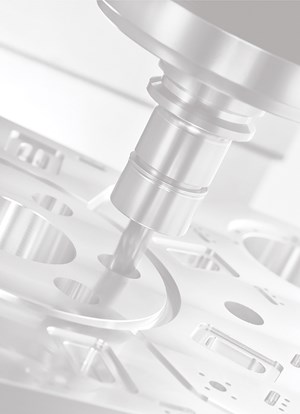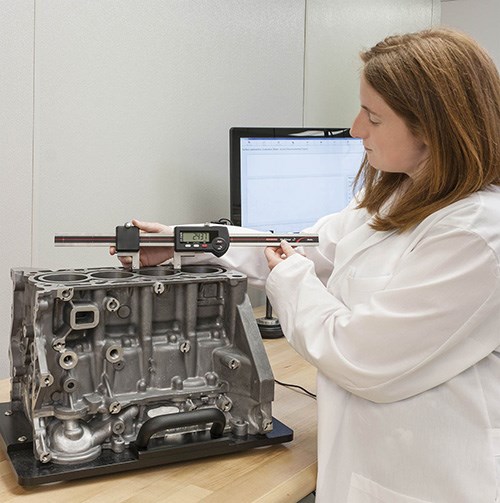How to Measure Special Diameters
More complicated checks sometimes require more versatile measurement systems with long ranges.
Share


Sometimes we are faced with making critical diameter checks on parts that do not present themselves in a straightforward fashion. Usually these checks are on the inside of some type of bearing that can be almost any size. Or they might be on a giant transmission housing large enough to walk through and include measuring the diameter of an internal surface behind a shoulder, where the entry diameter is smaller than the diameter being measured. Or they might require measuring a ring groove in a bore, the pitch diameter of an internal thread, the effective diameter of a barrel roller bearing or the included angle of a tapered bore.
Measuring these types of diameters requires that the gage have some unique characteristics. Depending on the tolerances, having the simple capability to make multiple diameter checks with a very versatile system may be the most critical requirement. Or you may have a situation where tight tolerances demand the high repeatability of a comparative gage, long-range jaw retraction to allow entry into the part, and the ability to set the depth of the contact to make the measurement at the proper point.
Many people immediately think of using a shallow-bore gage for this type of application. As we have discussed in the past, this type of gage rests on the face of the part and measures the inside diameter at a certain depth. These are fairly accurate comparative gages that allow the depth of the contact to be set to a specific location. However, these gages are typically limited by the amount of travel in the indicating device used for the readout. As simple fixed-diameter gages, they work well, but they do not meet the need for long range to get behind a shoulder or to have the contact measure the groove diameter they are generally set to measure. Nor do they have any versatility to check other dimensions.
Two types of measuring devices do meet the needs of these types of applications: universal caliper inner diameter/outer diameter gages, and long-range slides coupled with high-resolution, long-range digital indicators.
The universal caliper ID/OD gage is basically just as it sounds: a long digital scale with a readout, but also with two moving slides upon which interchangeable jaws/contacts are mounted. Universal is truly the right term, as this type of measuring instrument allows for the various jaw sets to be mounted on either the top or bottom of the display. No more trying to read upside-down measuring results. The other benefit of this type of arrangement is its versatility. The greatest benefit of any digital caliper is the versatility to measure multiple features. With these universal ID/OD gages, that benefit is compounded, as the increased range allows for expanded capacity. Both jaws can be set anywhere within the range of the tool, allowing it to be well balanced at the point of manufacture.
These long-range universal measuring systems serve a valuable role in the general inspection of large parts that have loose to medium tolerances. However, all caliper gages are subject to some operator influence related to gaging pressure, skill and scale accuracy over the long measuring range.
To take the process up to the next level requires a move to a comparative version of the system using a long-range digital indicator as part of the measuring frame. This has the benefit of actually referencing the measurement based on an external precision reference master—the accuracy built into the digital indicator's precision scale. The combination of the long-range, high-resolution digital indicator and a soundly designed mechanical frame can provide a universal ID (or OD) gage that has endless applications for those hard-to-reach inside measurement applications.
Of course, the contacts must be designed to handle the depth and gaging pressures, but the beauty of this type of gage is that its long range offers the ability to measure any number of depths within that range. So besides measuring a depth at a particular location, it can measure two diameters at different depths, thus becoming a taper gage measuring the included angle of the tapered bore.
Related Content
Understanding Process Damping in Milling Operations
Despite the advances in modeling machining operations over the past decades, process damping remains a topic of interest, including new tool designs that increase the effect.
Read More3 Considerations for Revising Design for Manufacturing Efforts
When revising part designs, investigate the 3D CAD, the 2D drawing and the part’s functional requirements to determine which details should be tightened up.
Read MoreObscure CNC Features That Can Help (or Hurt) You
You cannot begin to take advantage of an available feature if you do not know it exists. Conversely, you will not know how to avoid CNC features that may be detrimental to your process.
Read MoreHow to Mitigate Risk in Your Manufacturing Process or Design
Use a Failure Mode and Effect Analysis (FMEA) form as a proactive way to evaluate a manufacturing process or design.
Read MoreRead Next
OEM Tour Video: Lean Manufacturing for Measurement and Metrology
How can a facility that requires manual work for some long-standing parts be made more efficient? Join us as we look inside The L. S. Starrett Company’s headquarters in Athol, Massachusetts, and see how this long-established OEM is updating its processes.
Read More


















-02.jpg;maxWidth=300;quality=90)










